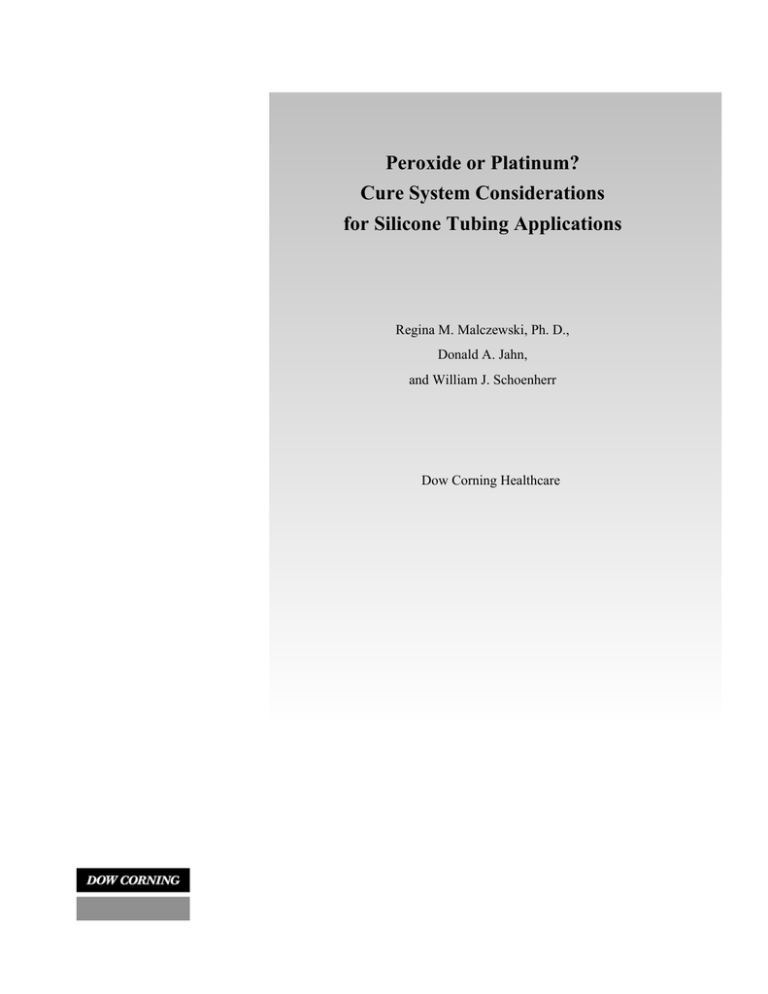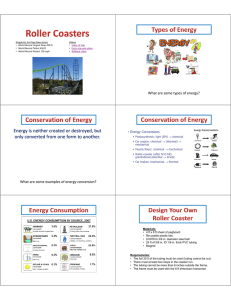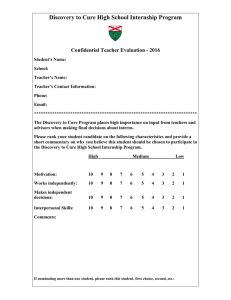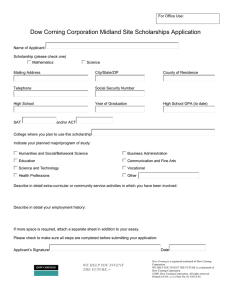
Peroxide or Platinum?
Cure System Considerations
for Silicone Tubing Applications
Regina M. Malczewski, Ph. D.,
Donald A. Jahn,
and William J. Schoenherr
Dow Corning Healthcare
Introduction
The FREE RADICAL CURE system is the oldest
crosslinking chemistry used for silicones. It has
been commonly called a “high temperature
vulcanizing (HTV)” system. This chemistry utilizes
free radicals generated by organic peroxides (see
Figure 2) that decompose at elevated temperatures,
initiating a crosslinking reaction.
Silicone tubing has many advantageous physical and
chemical properties that have been utilized in
medical and pharmaceutical applications for over 40
years. Silicone elastomer, from which tubing is
extruded, can be crosslinked and “cured” (or
“vulcanized”) into solids by using a variety of cure
systems. In health care applications the most
commonly used crosslinking chemistries are
addition (platinum) and free radical (peroxide)
curing systems. This paper will discuss the
advantages and disadvantages of both types.
The following are important considerations when
choosing among products with different cure
systems:
-acceptability of cure system by-products – do
they impact drug assay or efficacy?
-product performance – e.g., pump life, burst
strength
Figure 2. Silicone Crosslinking Using Radicals
-appearance differences that could impact visual
inspection of fluid contents
Peroxides are effective at levels around 1%; these
materials and their derivative radicals are consumed
during the reaction, although by-products remain.
These tend to be volatile organic acids, which can be
removed by exposing the tubing to elevated
temperature for an extended period (post-cure).
Reaction Chemistries
For tubing stocks, source polymers are typically
long chains of polydimethylsiloxane, either methyl
or hydrogen-substituted, and vinyl-functional
polydimethylsiloxane gums. An ADDITION CURE
system makes use of vinyl-functional polymers,
oligomers with Si-H groups, and a metal complex
catalyst, such as platinum (Pt). The reaction is
generally as follows (Figure 1):
Many types of peroxides are commercially available,
and these differ in formulation (vehicle
components), temperature of decomposition, and
decomposition products, which may all effect
product contamination.
Any material left in the tubing after cure that is not
an intrinsic part of the tubing matrix can be a
potential extractable; therefore, choice of cure
system can affect the accuracy of drug assays and
may also impact drug efficacy.
Impact of Fabrication and Cure
Conditions on Quality
Figure 1. Silicone Crosslinking by Addition
With free radical cure systems, the peroxide catalyst
is added to the silicone elastomer base and blended
by milling. Platinum-catalyzed systems are supplied
in two equal (by weight) silicone elastomer base
parts. Part A contains the platinum catalyst, and Part
B, the crosslinker. Again, thorough mixing by
milling is required to ensure the tubing cures
homogeneously without flaws like gels or voids.
Peroxide cure systems offer less control over cure
rates and crosslink distribution than do platinum
Addition cure has no by-products. Platinum in the
form of an organometallic complex is used to
catalyze Dow Corning® Pharma tubings, although
older chemistries utilize platinum salts. Typically 515 ppm of Pt is effective for catalysis. Catalyst costs
are higher than for peroxide cure systems, which
may be reflected in product prices.
2
catalyzed materials. Extract testing is an important
component of the assessment of materials that will
come into contact with fluids, especially if residence
time is extensive or temperatures and pressures are
elevated. Results are highly method-dependent,
however, and data comparisons must be done with
caution. Parameters such as sample configuration,
preparation and storage, as well as solvent choice,
time, temperature and surface area-to-volume ratio
can each have a significant impact on outcome.
systems, so the resulting tubing may be less
consistent in appearance. Cure is accomplished
during extrusion, where temperatures are typically
higher than those used for slabs or other fabricated
parts due to rapid throughput speeds. Extrusion
involves a die that produces a specific crosssectional shape along a continuous length. Hot air
vulcanizing ovens of vertical or horizontal
configuration are used. Post-cure of platinumcatalyzed tubings is not necessary as there are no
cure by-products, but heat treatment of peroxideinitiated tubings for four hours or longer after cure
may be needed to remove cure system residuals.
Organic (aromatic) acids in peroxide-vulcanized
tubings (which may be present to some extent even
after extensive post-cure) are believed to contribute
to the pH reduction and Total Organic Carbon seen
in water extracts (Table 2.) The post-cure used for
peroxide-cured tubing is effective in reducing the
extractable levels of low molecular weight siloxanes,
however2.
Perhaps as a result of extensive heat exposure, and
due in part to inherent differences in cure
mechanism, peroxide-cured tubings are sometimes
darker in appearance and more opaque than
platinum-catalyzed products. Peroxide-cured
materials may also have a higher surface tack, which
could translate to faster dust and dirt pick-up.
Translucency may be important if color or visual
viscosity checks are part of process monitoring. The
impact of bubbles, gels, drag lines and other physical
flaws on specific properties is unknown, but it is
possible that these tubing wall defects could impact
peristaltic pump life and burst performance.
Chemical and Physical Properties
Impacted by Cure System
Table 1 gives the physical properties of some
peroxide- and platinum-cured elastomers of similar
formulation. Although properties such as tensile,
elongation and modulus can be affected by catalyst
and crosslinker concentration, these data show the
differences that can be seen with analogous
materials of typical formulation.
Summary and Conclusions
Silicone tubing is widely used in the pharmaceutical
applications for two major reasons. First, and
foremost, is safety. Silicone tubing does not contain
plasticizers or other additives that could leach into a
drug product and cause toxicological issues.
Second, silicone tubing is highly flexible and tearresistant, making it a good choice for transporting
fluids between tanks, or for use in filling machines.
Peristaltic pump life is typically higher for peroxidecured tubings than for standard platinum-catalyzed
materials1. The generation of abrasion particles
during pumping (spallation) is related to pump
performance; longer life results in a lower average
weight of particles on a per hour of pumping basis.
There are cure system options with silicones,
however, that produce materials with different
characteristics, whose impact should be considered
before tubing selection. Silicone materials may be
cured using free radical (peroxide) or addition
(platinum) cure mechanisms. Peroxide-cured
As mentioned above, residuals in peroxide-cured
elastomers and tubing translate into potential
extractables which are not present in platinum-
1
Dow Corning Advanced Pump tubing, although Pt-catalyzed,
has higher pump life than standard Pt-cured products
2
3
Summaries of Health Data are available from Dow Corning for
tubings and extractable siloxanes
Polymers, Metals and Composites, M. Szycher, ed.,
Technomic Publishing, Lancaster, PA, 1983
materials have better pump life and reduced
spallation relative to standard platinum-catalyzed
tubings, but are less translucent and may be more
prone to other appearance flaws. In addition, there
may be physical property differences between
materials cured with these two systems. Peroxidecured tubings may have higher levels of organic
extractables, and produce more acidic extracts,
although low molecular weight volatiles are reduced
by the extensive post-curing used with these
materials. The relative value and impact of these
characteristics should be evaluated carefully when
selecting tubing for fluid handling applications.
Braley, S., “The Chemistry and Properties of the
Medical-Grade Silicones”; J. Macromol. Sci.-Chem.
A4(3), pgs. 329-544, May, 1970
Colas, A. and Curtis, J., “Silicone Biomaterials:
History and Chemistry” in Biomaterial Science, 2nd
Edition; B. D. Ratner, A. S. Hoffman, F. J. Schoen,
J. E. Lemmons, eds., Elsevier, Inc., 2004
Frisch, E. E., “Technology of Silicones in
Biomedical Applications” in Biomaterials in
Reconstructive Surgery, L. Rubin, ed.; C.V. Mosby,
St. Louis, 1983
References
Arkles, B. and Redinger, P. “Silicones in
BioMedical Applications”, in Biocompatible
Table 1. Comparison of Representative Silastic® Peroxidea-and Pt-curedb Elastomers
Typical Physical Properties
Property
Units
35-Durometer Elastomer
50-Durometer Elastomer
65-Durometer Elastomer
Pt-cured
Peroxidecured
Pt-cured
Peroxidecured
Pt-cured
Peroxidecured
Tensile
Strength
MPa
9.84
8.21
10.16
9.41
7.94
7.59
psi
1427
1190
1473
1364
1151
1100
Elongation
%
1171
971
903
596
890
590
Modulus at
200%
MPa
1.11
0.97
2.14
2.50
2.82
3.07
psi
161
140
311
362
409
445
Tear
Strength
(die B)
kN/m
36.6
24.5
45.9
35.9
45.5
42.2
ppi
209
140
262
205
260
241
a
Catalyzed with 2,4 dichlorobenzoyl peroxide, 1% w/w. Post-cured 2 hr at 350oF (177oC)
b
Cured at 240oF (116oC) for 10 min, no post-cure
4
Table 2. Comparison of Peroxide-and Platinum-cured Tubing
Extractablesa
Parameter/Extractable
Pharma-50 Tubing
(Pt-cured)
Water
Acetone
Pharma PXS-50 Tubing
(Peroxide-cured)
Water
Acetone
pH changeb
0
NAc
-2.3
NAc
Total Organic Carbon
(µg/g sample)
Residue (mg/g sample)
2.63
NAc
62.73
NAc
0
13.3
0
10.51
Total LMW siloxanesd
(µg/g sample)
NAc
10241
NAc
3837
a
3/8” x 5/8” tubing
Relative to control
c
Not applicable; assays cannot be performed in this solvent
d
Low Molecular Weight siloxanes are linear and cyclic siloxanes through D20; these materials/levels have no negative biological
effects3
b
LIMITED WARRANTY INFORMATION – PLEASE READ CAREFULLY
The information contained herein is offered in good faith and is believed to be accurate. However,
because conditions and methods of use of our products are beyond our control, this information should
not be used in substitution for customer’s tests to ensure that Dow Corning’s products are safe,
effective, and fully satisfactory for the intended end use. Suggestions of use shall not be taken as
inducements to infringe any patent.
Dow Corning’s sole warranty is that the product will meet the Dow Corning sales specifications in
effect at the time of shipment. Your exclusive remedy for breach of such warranty is limited to refund
of purchase price or replacement of any product shown to be other than as warranted.
DOW CORNING SPECIFICALLY DISCLAIMS ANY OTHER EXPRESS OR IMPLIED
WARRANTY OF FITNESS FOR A PARTICULAR PURPOSE OR MERCHANTABILITY.
DOW CORNING DISCLAIMS LIABILITY FOR ANY INCIDENTAL OR CONSEQUENTIAL
DAMAGES.
We help you
invent the future.™
DOW CORNING is a registered trademark of Dow Corning Corporation.
We help you invent the future. is a trademark of Dow Corning Corporation.
©2003 Dow Corning Corporation. All rights reserved.
www.dowcorning.com
Printed in USA
Form No. 52-1077-01



